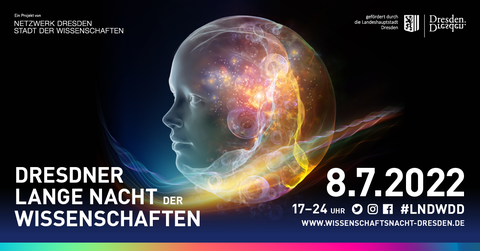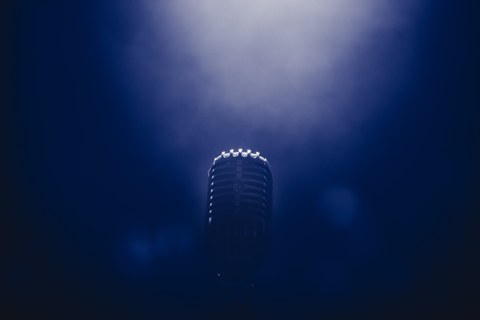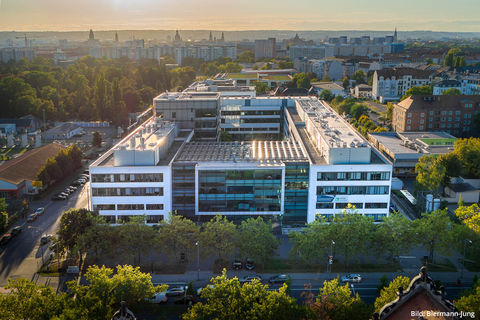Jun 16, 2022
Dresden Science Night live at the CRTD!
This year the Center for Molecular and Cellular Bioengineering (CMCB) opens its doors again for the Dresden Long Night of Science! Scientists from the B CUBE - Center for Molecular Bioengineering, Biotechnological Center (BIOTEC) and the Center for Regenerative Therapies Dresden (CRTD) are looking forward to get you excited about Life Sciences. You can expect various hands-on experiments, lectures, exhibitions, videos and more. More information about the program below.
Program (5 pm - midnight)
Exhibitions
Presenters:
Albert Group, Center for Regenerative Therapies Dresden (CRTD)
Description:
During fetal development, nerve cells are formed in the brain from neural stem and progenitor cells. Until now, it has been difficult to study this process in humans. New models in neuroscience, so-called brain organoids, now make it possible to study human brain development in 3D in the laboratory. Here you can look at brain organoids under the microscope and learn about exciting applications of these new models.
Presenters:
Ader Group, Center for Regenerative Therapies Dresden (CRTD)
Karl Group, Center for Regenerative Therapies Dresden (CRTD) and German Center for Neurodegenerative Diseases (DZNE)
Description:
Which challenges do blind people face? What is the anatomy of a healthy eye and how does it change upon degenerative diseases? What are retinal organoids and how can they help researchers to understand diseases and develop therapies? Come in and explore all of this in our darkroom experience, at the walk-in eye model and further stations.
Presenters:
Bergmann Group, Center for Regenerative Therapies Dresden (CRTD)
Description:
Here you will learn how human cardiac muscle cells are generated from pluripotent stem cells. The manufacturing process of heart muscle cells is visualized, and you will learn how beating 2D and 3D Heart muscle tissue structures are generated from pluripotent stem cells. You can look at beating engineered human heart tissue. To make it more exciting, you can control the frequency of beating yourself by stimulating the heart tissue with (blue) light, a potential new method for pacing the heart.
Presenters:
Yun Group, Center for Regenerative Therapies Dresden (CRTD), Max Planck Institute of Molecular Cell Biology and Genetics (MPI-CBG), and Cluster of Excellence Physics of Life (PoL)
Description:
Unlike humans, salamanders such as newts and axolotls can grow back body structures, including entire organs and even limbs. Come to meet these remarkable regenerators: you will learn how they live, develop and regenerate, and get in the shoes of a salamander researcher for a day. Could you help us unlocking the secrets of their regenerative powers?
Presenters:
Becker Group, Center for Regenerative Therapies Dresden (CRTD)
Ninov Group, Center for Regenerative Therapies Dresden (CRTD)
Description:
Zebrafish are an important model organism for studying regeneration and developmental biology. Come and check out live adult and larval zebrafish, and learn about how they live and swim! You can see how fish develop from egg to free swimming larvae, see fluorescent fish under the microscope, and learn how we collect fish eggs with a hands on activity. For children, we also have a fun fish craft which they can make and take home!
Presenters:
Light Microscopy Facility at CMCB
Description:
The CMCB Lightmicroscopy Facility has put every day items under a microscope to examine them with high magnification. Exciting details now become visible transforming these ordinary objects into fascinating samples.
Bring your own samples (stones, flowers, dead insects. etc.) if you like!
Presenters:
Albert Group, Center for Regenerative Therapies Dresden (CRTD)
Description:
Every human being consists of a large number of tiny building blocks, the cells. Our brain, which is responsible for our thoughts, feelings, speech and movements, is made up of cells, in particular nerve cells. These in many ways extraordinary cells are only a few micrometer in diameter, but can be a good meter long. Get to know the special properties of nerve cells and make a model of these cells that is as close to the original as possible!
Presenter:
Schroder Group, Biotechnology Center (BIOTEC) at TU Dresden
Description:
How can you find drugs against corona, cancer and other diseases? Drugs bind to proteins. Understanding these interactions allows us to search through large databases and discover new uses for known drugs. To do this, it is necessary to know how drugs bind to proteins and what they actually look like in 3D. We playfully illustrate how proteins fold in 3D and how drugs can bind.
Presenters:
Sandoval-Guzmán Group, Paul Langerhans Institute Dresden (PLID)
Description:
Playing with friends! Eating ice cream! Dancing! Your skeletal system is all about moving! Your bones and cartilage give you the possibility of doing all your favorite activities. This is also true for the axolotl, Mexico’s water monster.
Come and enjoy the fun of the axolotl world with us!
You will learn all about them, build your own axolotl skeleton and see with your own eyes how similar it is to ours. You will also discover the axolotl’s super power: regeneration!
Presenters:
Calegari Group, Center for Regenerative Therapies Dresden (CRTD) at TU Dresden
Description:
Brain is the seat of our consciousness, mind and soul. It controls and regulates almost all the functions of our body, yet we do not fully understand how. In this booth, we will use interactive kits developed by the ‘Backyard Brains’, to demonstrate how the brain communicates with the rest of the body. We will talk about how plants’ and animals’ nervous systems also use the same signals. We will also show how these signals can be used to communicate with other human beings and machines!
Presenter:
Petra Lenning, Biomolecular Synthesis Facility at CMCB
Description:
Many drug candidates are obtained through so-called screening. But compounds found in screening usually do not yet show the desired properties. How can you improve a chemical compound, and how can you change a molecule so that it throws the enzyme it binds to the cell’s garbage disposal?
Presenters:
Brankatschk Group, Biotechnology Center (BIOTEC) at TU Dresden
Description:
Taste is everyone's business, and it's open to debate. Wine culture offers us a good insight into this: would you prefer a sweet red or a fruity white? It's best to let true experts decide: the fruit flies. These insects can perceive alcohol and other yeast products over long distances. Learn more about taste and compare your preferences with those of the flies.
Presenters:
Bringmann Group, Biotechnology Center (BIOTEC) at TU Dresden
Description:
Since the 60s, scientists have been trying to solve biological problems by observing and conducting experiments on a worm, Caenorhabditis elegans. It is small, transparent, reproduces fastly, lives short and sleeps. Through a stereomicroscope, participants will see the variety of living worms daily grown in a lab for experiments and why they are useful: rollers, uncoordinated, dumpy and many more. But be quiet. Worms need sleep too. Do you want to know why?
Presenter:
Kröger Lab, B CUBE - Center for Molecular Bioengineering
Description:
Algae are often only perceived as an annoying algae bloom or slime on stones, but they are one of the most ecologically important organisms on earth. Diatoms are the most abundant microscopic algae that produce one-fifth of the oxygen we breathe and have beautiful cell walls made of glass (SiO2). Under the microscope you can marvel at diatoms from all over the world (including Dresden), create your own diatom window art, and learn interesting facts about their role in nature and technology.
Presenters:
Politi Group, B CUBE - Center for Molecular Bioengineering
Description:
Many insects and spiders possess structures with unique properties that confer advantageous abilities. Building blocks organise themselves into intricate patterns across different scales to produce functions. We research the principal and one of the most abundant building block in nature, called chitin, and its organisation, and bio-chemi-physical interactions. Immerse yourself in nature's structures and materials, find the 'trickster' beetle, and take home a self-made souvenir.
Presenters:
Schlierf Lab, B CUBE - Center for Molecular Bioengineering
Description:
The cells that keep our bodies working are like factories consisting of libraries and millions of tiny machines: DNA and proteins. Together they store the genetic information of our organism, transport nutrients, replicate the cell, and defend our body against infection. On our stand we introduce you to this fascinating world of machines and the possibilities of modern microsopy.
Presenter:
B CUBE - Center for Molecular Bioengineering
Description:
The B CUBE – Center for Molecular Bioengineering focuses on investigating natural phenomena across scales and translating this knowledge into synthetic material using biologically inspired design concepts, thereby building bridges between Life Sciences and Engineering Sciences. High-end microscopy is at the core of all B CUBE research groups. We will demonstrate a number of microscopy techniques and you have the chance to take home your own cardboard microscope (Foldscope).
Presenter:
Students from the Martin-Andersen-Nexö-Gymnasium (MANOS)
Description:
Students from the Martin-Andersen-Nexö-Gymnasium (MANOS) present experiments on biological, chemical and physical phenomena. There will be oxyhydrogen-banging, tiny details will become visible and colorful structures will emerge.
Presenters:
Cluster of Excellence Physics of Life (PoL)
Description:
Why do we need Physics in Biology? In fact, we need it a lot! With hands-on-experiments, videos, and demonstrations we want to show you how biological cells generate mechanical forces, e.g., to divide, change shape, or move inside the body exactly where they are needed. How this works, and how these processes are switched on and off during the development of an embryo or when tissue repairs itself is what we want to find out in the Cluster of Excellence Physics of Life (PoL).
Presenters:
Buchholz Group, Faculty of Medicine Carl Gustav Carus
Description:
Cell and gene therapies are innovative medicines that could change our approach to healthcare. This growing field in biotechnology is unlocking possibilities for a more targeted, personalized treatment. We give an overview of the current technologies, CRISPR/Cas9 and recombinases as well as the newly developed epigenetic editors. In addition, we present and discuss current approaches and projects from our laboratory.
Talks
CRTD Auditorium Left
Speaker:
Dorit Teichmann, Startup Managerin an der TU Dresden
Language:
German
CRTD Auditorium Left
Speaker:
Dr. Maximina Yun, Center for Regenerative Therapies Dresden (CRTD), Max Planck Institute of Molecular Cell Biology and Genetics (MPI-CBG), and Cluster of Excellence Physics of Life (PoL)
Duration: 40 min
Language: English
Description
Humans exhibit rather limited capabilities for tissue repair and regeneration. In contrast, organisms with remarkable regenerative abilities can be found in nature.
Among these, salamanders such as newts and axolotls truly stand out, being able to regrow an extraordinary range of body parts including ocular tissues, tail, jaws, parts of their heart and nervous system, and entire limbs throughout their life. In this talk we will discuss the salamander's impressive regenerative abilities and how they can help us design therapeutic strategies for cell and tissue replacement.
9:30 pm - 11 pm, CRTD Auditorium
Can science be fun, entertaining, and informative?
How about all this in just under 5 minutes?
Our scientists took up the challenge! Prepare yourself for the coolest form of science: the Science Slam.
Join us and listen to short pitches that explore a variety of scientific topics from the field of Life Science.
Videos
Wie kann ein kleiner Fisch zur Forschung beitragen?
In kurzen Videos erklären Wissenschaftler mit Hilfe von Puppen, wie die Fische zur Forschung hier in Dresden beitragen. Es wird gezeigt, wie Zebrafische unter dem Mikroskop aussehen und wie ihr Gehirn und Herz funktionieren. Außerdem wird veranschaulicht, wie die beta-Zellen der Bauchspeicheldrüse in unserem Körper, die den Glukosespiegel steuern, auf den Zucker Glukose reagieren.
Vortragende: AG Ninov, Zentrum für Regenerative Therapien Dresden (CRTD)
Dauer: 30 min
Sprache: DE
Ort: rechtes Auditorium
Meet four scientists researching Life Science across Europe. They study zebrafish, a small fish with an impressive ability to regenerate a variety of different tissues. Tune in to learn where zebrafish comes from, how it develops, and what it lets us see. Stay along for a short theatre play, in which Streifi, a zebrafish, takes a wonderful journey around the world. Enjoy!
Presenter:
Juniorprof. Franziska Knopf (Center for Regenerative Therapies Dresden - CRTD),
Margrit Kamel (Ninov lab, Center for Regenerative Therapies Dresden - CRTD),
Nandini Asokan (Goetz lab, Institut national de la santé et de la recherche médicale - INSERM),
Vasiliki Tsata (Beis lab, Biomedical Research Foundation Academy Of Athens - BRFAA)
Duration: 30 min
Language: EN/DE
Ort: rechtes Auditorium
Place
All events will take place at the CRTD:
Fetscherstraße 105, 01307 Dresden, Germany



